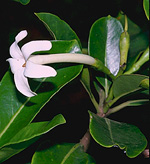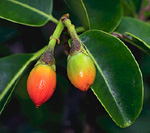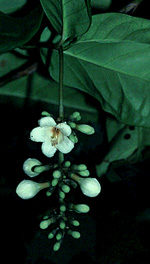 |
This moderate-sized family from tropical, subtropical and (occasionally) warm-temperate parts of the world, is represented in Australia by 9 genera usually found in forests, woodlands and heathlands, especially on moist, sandy soils. Centres of diversity are in the drier parts of south-western Western Australia and from southern South Australia to eastern New South Wales; some genera are found in monsoonal woodlands and drier rainforests and vine scrubs across the tropical north. Few species occur in the arid zone.
Characteristic features of the family Loganiaceae in Australia include: - trees, shrubs, woody climbers or herbs with simple, opposite leaves, the bases of which are joined by a stipule or sheath (sometimes reduced to a narrow ridge or line)
- flowers solitary or in cymes, bisexual, regular, with 4 or 5 fused or free sepals and the same number of petals which are fused into a narrow or broad tube
- ovary superior (rarely semi-inferior) with a single, divided or undivided
style or (in Mitrasacme) with two styles that are free at the
base and joined above
- fruit a berry or capsule
Description
Evergreen trees, or shrubs, or rarely woody or herbaceous vines climbing by twining or scrambling stems, or annual or perennial terrestrial herbs or epiphytes. Perennating by taproots. Stem nodes not conspicuously swollen, or rarely so. Internal secretions not obvious. Plants glabrous, or with simple, non-glandular, unicellular or uniseriate hairs. Leaves well developed or rarely much reduced (i.e. to scales, etc), opposite or rarely whorled, or if herbs then the leaves cauline, all or mostly cauline, or both basal and cauline, petiolate, subsessile or sessile. Stipules absent, or present and intrapetiolar or interpetiolar, scale-like or membranous, persistent or falling off early. Lamina simple, symmetric, filiform, acicular, subulate, linear, lanceolate, ovate, elliptic, oblanceolate, ovate, oblong or rarely orbicular; base cuneate, attenuate, rounded or rarely cordate; margins entire, ±flat, revolute or recurved; one-veined, or the venation pinnate, with the midrib conspicuous or inconspicuous, and the tertiary venation reticulate or not reticulate; surfaces not punctate; herbaceous or leathery. Male and female flowers occurring on separate plants, or with all the flowers bisexual. Inflorescences terminal or axillary, consisting of panicles, cymes or umbels or solitary flowers. Bracts present. Bracteoles present or absent. Mucilaginous hairs present, or rarely absent on buds. Pollination by insects or ?birds. Flowers odourless or fragrant, stalked. Floral disc absent. Floral nectaries absent or on the perianth. Perianth regular, of 2 dissimilar whorls or of 1 whorl only, or all whorls ±similar. Epicalyx present or absent. Calyx rarely petaloid; segments free or fused, with 4–5 sepals or lobes, imbricate or open in bud; calyx bell-shaped, urn-shaped or funnel-shaped, herbaceous. Corolla segments fused, with 4–5 lobes, alternating with the sepals or calyx lobes, imbricate or valvate in bud; corolla wheel-shaped, bell-shaped, urn-shaped, funnel-shaped, salver-shaped or tubular, white, cream, yellow, orange, magenta, purple or green, without contrasting markings, or streaked, spotted, etc, membranous; claws absent; lobes ±entire. Fertile stamens 4 or 5, opposite to the sepals or calyx lobes, at least partly fused to the corolla, free of the ovary and style, distinct from each other, all ±equal. Anthers dorsifixed or basifixed, versatile or not, opening outwards, sideways or inwards by longitudinal slits, 2-celled, sometimes with terminal appendages. Ovary superior and sessile, or part-inferior. Carpels 2, fused; ovary with 1–2 locules. Style terminal, single and unbranched, or branched above; stigma papillae present. Ovules 1–numerous, stalked or sessile; placentation axile. Fruit a dry, dehiscent valvular, septicidal or loculicidal capsule, or a fleshy, indehiscent berry; the perianth on the maturing fruit deciduous, dry and persistent or growing larger. Disseminule macro-surface featureless or winged; micro-surface ±smooth, reticulate, verrucose or sulcate, white, yellow, orange, red, pink, blue or brown, glossy or dull. Seeds 1–numerous per fruit. Aril present. Cotyledons 2. Embryo straight or curved.
(Note: this description has been generated from the coded data compiled for the key. Any errors in the key data will be reflected in the descriptions.)
A treatment of the family Loganiaceae has been published in:
Flora of Australia 28: 172.
Australian genera of Loganiaceae (as recognised for the Flora of Australia)
* = all species introduced
Fagraea
*Gelsemium
Geniostoma
Logania
Mitrasacme
Mitreola
Phyllangium
Schizacme
Strychnos

|
  |

Fagraea berteriana (flower)
Photo: D.Jones © D.Jones

Fagraea berteriana (fruits)
Photo: D.Jones © D.Jones

Fagraea racemosa (flowers)
Photo: G.Sankowski © Zodiac Publications

Geniostoma rupestre (flowers)
Photo: H.Nicholson © H. & N. Nicholson

|
 |
|